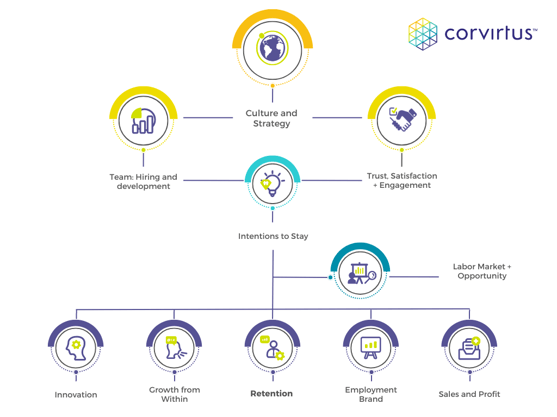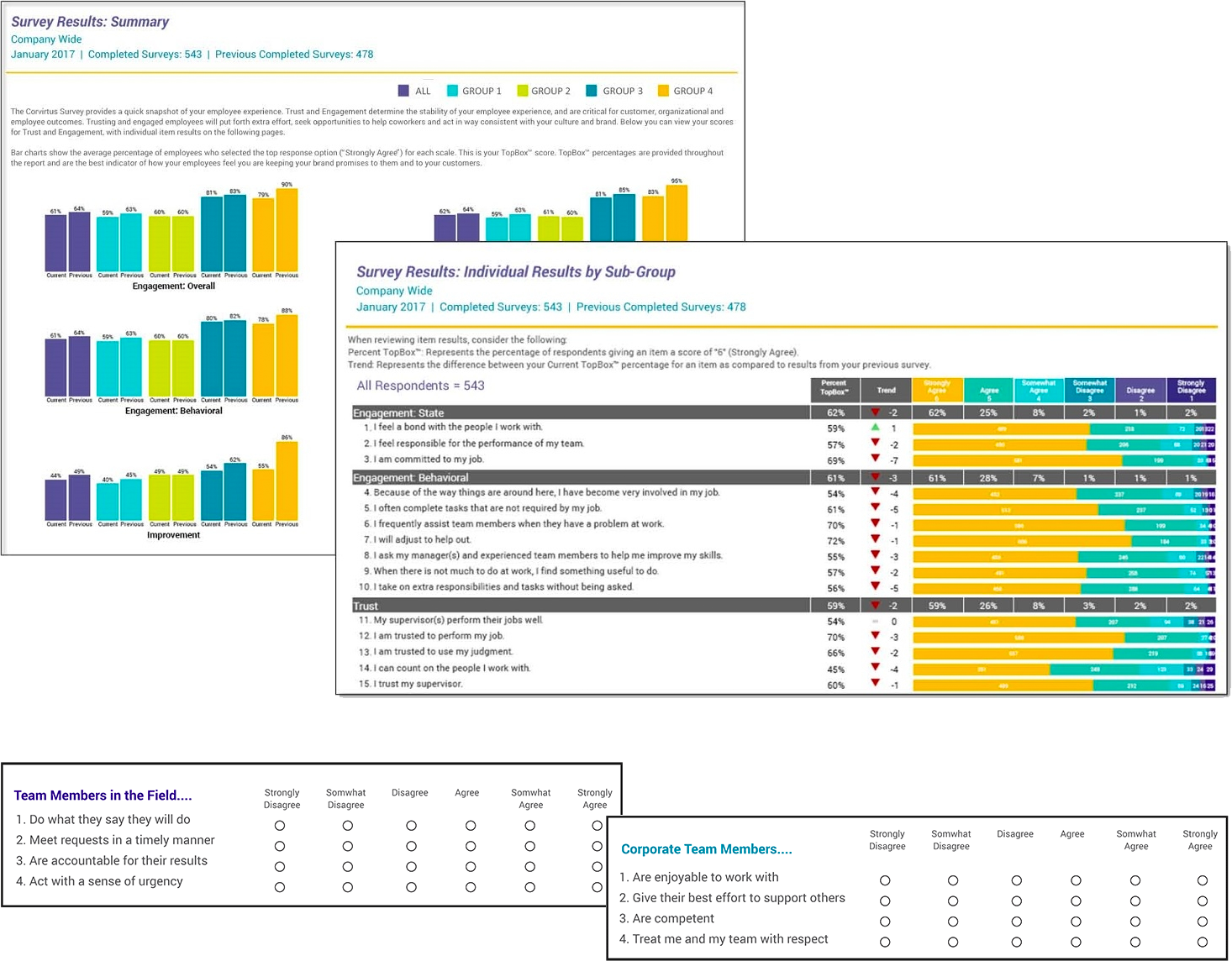Resources for Strengthening Employee Engagement + Retention

How to Improve Employee Engagement & Retention
Transforming teams requires a strategic approach grounded in scientific principles, particularly when focusing on employee engagement. By leveraging data-driven methods, organizations can foster a culture of collaboration and satisfaction. Such an approach involves understanding the factors that motivate employees and then aligning these factors with the broader goals of the company. Key tactics include open communication channels, periodic feedback loops, and the use of technologies that facilitate teamwork.
Scientifically-backed assessments can also be instrumental in identifying team dynamics and individual strengths, thus enabling customized strategies that boost both engagement and productivity. By applying these scientifically-driven methods, organizations can experience reduced turnover, greater job satisfaction among employees, and ultimately, improved business performance. This approach doesn't just elevate the team but also aligns with organizational objectives, making it a win-win for everyone involved.
Table of Contents
- Strategies to Boosting Employee Engagement and Retention
- Four Key Focus Areas for Retaining Employees
- Employee Retention: Strategies for a Committed Workforce
- Empowering Teams with Science-Based Strategies for Employee Engagement
- Building a Collaborative Culture
- Planting the Roots of Engagement with the Employee Experience
- Employee Engagement with Stay and Exit Research
- Is There a Darkside to Teamwork?
- New Manager Retention: Stop, Collaborate, and Listen
- Supporting Employee Well-Being + Engagement in a Cost of Living Crisis
- Retaining and Developing your Top Performers is Crucial
- Takeaways
- Conclusion
Strategies to Boosting Employee Engagement and Retention

Increasing employee engagement and retention remains a top priority as organizations adapt to the evolving landscape of work. Three realistic strategies can serve as a framework for improving these areas.
First, regular and open communication between leaders and team members is vital. Leaders should foster an environment where employees feel comfortable sharing their thoughts and ideas, ensuring that they feel heard and valued. This sense of belonging can enhance engagement and make employees less likely to seek opportunities elsewhere.
Second, investing in professional development opportunities is crucial. By providing resources for skill-building, certifications, or mentorship programs, organizations signal that they are committed to the growth of their employees. This investment not only aids in skill acquisition but also boosts morale and job satisfaction, making employees more likely to stay long-term.
Lastly, adopting a flexible work model can be a game-changer. As remote work and hybrid models become more common, organizations that provide flexibility in work locations and hours are seeing increased levels of employee happiness and productivity. This approach recognizes the diverse needs of the workforce, making it easier for individuals to balance work-life responsibilities while remaining engaged in their roles.
By focusing on these strategies—open communication, professional development, and work flexibility—organizations can build a more committed, satisfied workforce that not only contributes to the bottom line but also serves as an ambassador for the company culture. These approaches are both pragmatic and impactful, offering a road map for sustainable improvement in employee engagement and retention.
Change Management
Prioritizing Employee Safety and Well-being
Communication
Four Key Focus Areas for Retaining Employees
Amid ongoing economic challenges and HR challenges, recruiting and nurturing high-potential talent has become more complex. Are you keeping your top performers fully engaged?

Consider these insights:
Up to 10% of your team's productivity can be attributed to the top 1% performers.
High performers are pivotal for innovation. A McKinsey study found that these strong performers generate double the revenue compared to their average peers.
These individuals are more adaptable, with almost half expressing readiness to relocate for new opportunities.
Monitoring turnover, both voluntary and involuntary, is crucial. It provides insights into the reasons behind employee departures.
Precise documentation and coding of termination reasons are essential. This consistency in coding helps in analyzing the primary causes of separations, revealing trends like performance issues or cultural misalignment.
With voluntary turnover, exit interviews or surveys provide valuable feedback. Conducting these a week post-separation yields high response rates. Alternatively, direct conversations with departing employees offers immediate insights.

Key Questions to Address Retention Challenges
When analyzing turnover, consider these questions:
- Are employees leaving for new job opportunities? Could your organization have offered similar roles internally?
- Are they departing for better compensation or benefits? Could your company have improved their offer?
- Is the leadership contributing to their departure? Exit surveys or employee experience surveys can shed light on this.
- Are departures linked to dissatisfaction with the company's products, services, or resources? Confidential surveys can help uncover these issues.
Understanding and Enhancing Trust, Satisfaction, and Engagement
While understanding turnover causes is reactive, proactively assessing trust, satisfaction, and engagement can preemptively address retention issues.
Review the model below to see how perceptions of trust, satisfaction, and engagement directly impact employee retention.

Using employee experience surveys, you can identify areas needing improvement, rather than relying solely on management opinions or turnover data. For example, dissatisfaction with compensation may stem from other issues like workplace environment or leadership quality.
For effective retention strategies, employers should focus on the four main areas: trust, satisfaction, engagement, and overall work environment improvement.
Employee Retention: Strategies for a Committed Workforce

The topic of employee retention is increasingly gaining attention, especially in today's competitive job market. A key insight is that retention starts with the recruitment process; identifying candidates whose values align with the organizational culture is crucial. This not only increases job satisfaction but also fosters long-term commitment. The emphasis here is on the 'fit' — not just from a skillset perspective but also in terms of values, expectations, and career goals.
Additionally, onboarding is another critical phase in an employee's journey. A well-designed onboarding program can significantly impact how quickly a new hire integrates into the team, understands their role, and starts contributing to organizational success. It's not just about orientation; it's about integration — making the new employee feel like a valuable part of the team from day one.
Beyond recruitment and onboarding, ongoing support and development opportunities play a major role in retaining talent. This includes not only skill-based training but also mentorship programs, career development paths, and continuous feedback mechanisms. The focus should be on holistic employee development that aligns individual aspirations with organizational objectives.
Leadership is the backbone of retention strategies. Managers need to be equipped with the right tools and insights to recognize employee needs, address concerns, and create a working environment that motivates and retains staff. In essence, retention is not a standalone process but a complex interplay of multiple factors that require integrated efforts across various departments in an organization.
Addressing the issue of employee retention requires a multi-faceted approach that takes into account both the individual and organizational factors at play. One of the critical components is the role of leadership in fostering an environment where employees feel valued and engaged. Leaders must be equipped with the skills to communicate effectively, set clear expectations, and provide regular feedback. In doing so, they create a supportive atmosphere that can significantly impact employee commitment and job satisfaction.

Equally important is the alignment of personal and organizational values. When employees see a direct correlation between their contributions and the company's overarching goals, it can create a sense of purpose that further enhances retention rates. Utilizing tools like employee engagement surveys can offer valuable insights into areas for improvement, serving as a basis for targeted interventions.
Moreover, implementing career development programs can act as a retention catalyst. Employees are more likely to stay with an organization that invests in their growth and offers avenues for advancement. By focusing on leadership, value alignment, employee feedback, and career progression, organizations can build a strong foundation for long-term employee retention, thereby creating a more stable and productive work environment.
Empowering Teams with Science-Based Strategies for Employee Engagement

In today's competitive business landscape, employee engagement is more than just a buzzword—it's a strategic imperative that directly impacts an organization's performance. The piece "Transforming Teams Through Science-Driven Employee Engagement Strategies" offers a groundbreaking approach to this critical issue, leveraging principles from industrial-organizational psychology. This multi-faceted viewpoint addresses not only what engages employees but also how to sustain that engagement long-term.
The content outlines a variety of empirically-backed strategies designed to elevate team performance through enhanced engagement. These approaches range from fostering a culture of open communication and trust to implementing data-driven performance metrics that align with organizational goals. The key takeaway is that genuine, sustainable engagement is achieved not through one-off initiatives, but by creating an organizational ecosystem where employees feel valued, empowered, and aligned with the mission.
Vigor
Not just physical energy but also the emotional and cognitive resilience to face work challenges head-on.Dedication
An emotional investment in one’s work, characterized by a sense of significance, enthusiasm, and challenge.
Absorption
A state of flow where employees are so deeply involved in their tasks that they lose track of time, fully engaging their skills and talents.
For leaders, managers, and talent management professionals, the insights provided in this piece serve as a roadmap for building more cohesive, effective teams. The strategies discussed offer a holistic view, ensuring that engagement is not just a flash in the pan but a sustained effort that drives business outcomes. It is an invaluable guide for organizations aiming to achieve high levels of employee engagement, satisfaction, and ultimately, retention.
The relationship between collaboration and employee engagement is a vital subject that offers actionable insights for talent management and organizational development. Building a collaborative culture can significantly enhance not only productivity but also employee satisfaction and retention. To this end, effective strategies include fostering open lines of communication, investing in collaborative technologies, and aligning individual goals with the broader organizational objectives.
Creating trust among team members is also essential. It lays the foundation for sharing ideas and information openly, thereby contributing to a thriving workplace environment. Leaders play a crucial role in setting the stage for teamwork. They should act as facilitators and role models, emphasizing the importance of collective input and shared responsibility.
Another noteworthy point is the selection of appropriate tools and technologies designed to foster teamwork. Whether it's project management software or communication platforms, these tools should be intuitive and inclusive, allowing all members to contribute to their full potential.
By applying these strategies, organizations can achieve several goals simultaneously. Employees become more engaged, leading to improved job satisfaction and reduced turnover rates. Additionally, these practices can drive tangible business outcomes by creating a more agile, responsive, and committed workforce. In essence, collaboration isn't just an HR trend; it's a strategic necessity that can deliver multifaceted benefits for both individuals and the organization as a whole.
Importantly, these tactics are not just theoretical: they are supported by real-world case studies and empirical evidence. "Unlocking the Power of Collaboration for Employee Engagement" offers in-depth insights into the symbiotic relationship between team collaboration and workforce engagement.
The concept of employee engagement can be understood through the metaphor of roots and fruits. The 'roots' refer to the foundational elements such as trust, open communication, and a sense of belonging that must be present in an organization. These form the basis upon which engagement grows. The 'fruits' are the visible outcomes, including increased productivity, higher job satisfaction, and reduced turnover rates. To cultivate a fully engaged workforce, organizations must first invest in creating a strong root system. This involves transparent leadership, fostering a collaborative environment, and aligning individual goals with organizational objectives. Once the roots are strong, the fruits manifest naturally, benefitting both employees and the organization. Thus, focusing on the foundational aspects is crucial for achieving lasting employee engagement and, consequently, superior business results.
Storytelling to Boost Retention and Engagement
Focusing on employee retention and engagement is crucial for any organization looking to thrive in today's competitive landscape. Strategies include providing clear career paths, developing a robust onboarding process, and offering ongoing training programs. Recognizing and rewarding employees for their contributions can significantly boost morale and commitment, while flexible work arrangements, such as remote work options, can contribute to work-life balance and job satisfaction.

Employee surveys and feedback mechanisms are invaluable tools to understand what employees value most, allowing for targeted interventions. By implementing these approaches, companies can not only retain their top talent but also create a more engaged and productive workforce. These methods have the added advantage of contributing positively to the organization's bottom line, as high levels of engagement and retention often correlate with increased profitability and customer satisfaction.
Tell new employees stories about your organization and team early to gain commitment to your values, norms, and vision.
Research shows that sharing real-life stories about employees embodying company values is more effective than stating those values outright. Such storytelling positively impacts team contribution and likely improves employee retention, as team members value their contributions more.
Incorporate stories that involve people similar to your audience.
Story-telling is an effective onboarding tool, but its impact varies based on the relatability of the stories told. Newcomers perform better and show greater commitment when they hear stories about people in positions similar to theirs, rather than tales about high-level executives. This "me too!" effect boosts both performance and retention.
Keep it positive!
Starting a new job often comes with cautionary tales about rule violations. However, such stories can backfire, leading to increased deviant behaviors among newcomers, particularly if the story involves a similar role.
Encourage employees to share and reflect on how their unique strengths and values can improve their performance.
An experiment at a call center found that onboarding programs encouraging self-expression and alignment with individual goals led to significant improvements in employee retention and engagement. Newcomers in this program were 47% more likely to remain employed after six months and showed three times greater commitment and job satisfaction compared to those in traditional training.Employee Engagement with Stay and Exit Research
Stay Interviews: A Preventive Measure
Stay interviews identify drivers of employee engagement but can also reveal the stressors inherent in teamwork, helping organizations tailor initiatives to improve both staff morale and patient outcomes.Exit Interviews: Learning from Loss
Exit interviews reveal crucial insights into high turnover, including issues like poor management, low job satisfaction, and inadequate training. Third-party consultations offer confidentiality and drive meaningful organizational changes.
The Proven Benefits
While investing in employee engagement yields positive business outcomes, the focus on exit interviews over stay interviews signals missed opportunities. Moreover, high turnover costs in healthcare, reaching up to $6.2 billion, underscore the urgent need for proactive retention strategies.
While teamwork is often touted as a critical factor for organizational success, it comes with its own set of challenges that could potentially lead to the loss of top-performing employees. In particular, the imbalance of effort among team members can create a sense of inequity, causing high-performers to feel undervalued and unappreciated. The perception that their contributions are not recognized or fairly rewarded can lead to decreased motivation and job satisfaction.
Additionally, the lack of autonomy in a team setting may stifle the creativity and initiative of top performers. Often, these individuals thrive in environments where they can take ownership and execute tasks without excessive oversight. Team structures that do not allow for this freedom can lead to frustration, disengagement, and ultimately, attrition.
Furthermore, the "social loafing" phenomenon, where some team members exert less effort because they believe others will pick up the slack, can be demoralizing for high-achievers. They may end up shouldering a disproportionate amount of the workload, leading to burnout and disengagement.
In sum, while teamwork has its merits, it's crucial for organizations to be aware of these pitfalls. Balancing collaborative efforts with individual recognition and autonomy is key to retaining top talent and fostering a truly effective team dynamic.
New Manager Retention: Stop, Collaborate, and Listen
Stop
Provide new managers with a clearly defined leadership model before they start their roles to set expectations and navigate challenges. This model should span from Self-Leadership to Culture Leadership, outlining competencies and requirements for success. By doing so, you facilitate smoother transitions and set a pathway for employee growth.Collaborate
Effective collaboration is critical for managerial success, impacting relationships both within teams and throughout the organization. Utilize structured tools like personal insight surveys for new managers to understand their leadership styles and potential challenges. Implement scheduled succession planning reviews to gauge and standardize talent evaluation. For performance feedback, employ 360-degree surveys to identify perception gaps in competencies, enabling prompt corrective actions. Training and open feedback channels are essential for new leaders to navigate challenges and excel in their roles.
Listen (to the data)
The final step for retaining new managers involves consistently collecting and utilizing data. For meaningful retention improvements, it's vital to measure performance and gauge employee sentiments such as satisfaction, trust, and engagement. Metrics, particularly turnover rates, should be monitored before and after any updates to leadership development initiatives or managerial changes. It's also important to analyze retention across various demographic groups to identify if specific subsets of managers are leaving more than others.Supporting employee well-being is more than an expense; it's a strategic asset that can significantly impact long-term loyalty and productivity. A one-size-fits-all approach to benefits won't suffice. Instead, organizations must adopt a data-driven, listen-first strategy to understand the unique challenges and needs of their workforce. By doing so, tailored programs that address these specific issues can be developed, ensuring they make a real difference in employees' lives.
It's essential to incorporate inclusivity and equity into the design of these benefits programs. A well-crafted program considers the diverse backgrounds, experiences, and circumstances of each team member. Whether it's financial aid, mental health support, or career growth opportunities, every offering should be accessible and meaningful to all employees, irrespective of their socioeconomic status or background. By taking this comprehensive approach, companies not only improve employee well-being but also create a more engaged, committed, and productive workforce.
Retaining and Developing your Top Performers is Crucial

We specialize in offering a range of survey solutions designed to understand and address the critical factors that drive employee engagement and turnover. Our Core and Enhanced Surveys focus on key questions that offer insights into overall employee experience, including aspects like their intentions to refer others or quit. For teams looking to track their progress in real-time, our Pulse Surveys offer a shorter, more frequent assessment tool.
We also offer Custom Surveys tailored to your organization's unique culture and needs, allowing you to find answers to your specific questions. Additionally, our Corporate-Field Effectiveness Surveys provide a comprehensive analysis of both corporate and field performance, helping to identify expectations, bridge performance gaps, and offer actionable steps for improvement. With these survey tools, your organization can enhance employee performance, build a robust referral program, and minimize turnover effectively.
Takeaways
Understanding and enhancing employee retention is critical for any organization aiming for long-term success. One of the pivotal approaches to achieve this involves integrating analytical tools that can predict turnover risks and provide insights into employee behavior. Such tools can capture a wide range of data, including performance metrics and engagement levels, and analyze them in the context of the organization's unique culture and goals. This information can help identify the underlying issues contributing to employee disengagement or potential departure. Armed with this knowledge, companies can take targeted action to improve the work environment, optimize job roles, or offer tailored growth opportunities. By taking a proactive, data-driven approach to retention, organizations can significantly reduce turnover costs, improve employee satisfaction, and build a more committed and effective workforce.
Conclusion
Employee retention is vital for a company's longevity and involves creating an engaging and appreciative work environment. Tailored strategies are needed to meet the diverse needs and goals of the workforce, with alignment between personal ambitions and company objectives being key to keeping employees invested. Open lines of communication for feedback and recognition are essential. Technology, such as performance management systems and data analytics, aids in understanding and improving employee engagement. Leaders should use these insights for precise actions to retain top performers. Ultimately, a nuanced and well-informed approach is necessary for fostering a dedicated and high-performing team.




.jpg?width=640&height=427&name=oleg-ivanov-RW06o1zE9Q8-unsplash%20(1).jpg)